|
|
Kota Kuala Kedah
Kedah's bastion of independence.
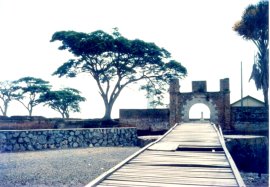 Kuala
Kedah Fort (Kota Kuala Kedah) is situated at the mouth of the Kedah
river, less than 10 kn from Kedah's capital Alor Setar. Rectangular in
shape, its sits on the northern bank of the river, with its west wall
facing the Straits of Melaka, the south wall overlooking the river
towards the town of Kuala Kedah, the north wall facing a thick mass of
mangrove swamps and the east wall facing a small fishing village and
padi fields. Surrounding the landward facing walls is a water-filled
moat, known locally as Alor Melaka. Kuala
Kedah Fort (Kota Kuala Kedah) is situated at the mouth of the Kedah
river, less than 10 kn from Kedah's capital Alor Setar. Rectangular in
shape, its sits on the northern bank of the river, with its west wall
facing the Straits of Melaka, the south wall overlooking the river
towards the town of Kuala Kedah, the north wall facing a thick mass of
mangrove swamps and the east wall facing a small fishing village and
padi fields. Surrounding the landward facing walls is a water-filled
moat, known locally as Alor Melaka.
While it was still a functioning military outpost, it housed
buildings for a royal palace, guard houses, canteens, an arsenal and
numerous thatched huts where they soldiers lived. A drawbridge at the
main gate spanned the Alor Melaka on the east side. It was ringed with
brass cannons on all sides except the wall facing the mangrove swamps.
 It
is ironic that a fort that was to become the scene of so many last
ditch struggles for Kedah's independence, actually began life as an
outpost for the Malay Peninsula's first Western colonizers - the
Portuguese. Formerly called Kuala Bahang and the fort was built during
the reign of Sultan Sulaiman of Kedah (1602-1619) with the help of the
Portuguese. Its very rectangular shape indicates that it probably
served more as a trading factory for use by the Portuguese rather than
a military fortification designed with bastions, strong points and
fields of fire. Nevertheless, being an outpost occupied by the
Portuguese, it certainly became a target for their main adversary
during the period - Acheh. The Achehnese Sultan Mahkota Alam attacked
the fort in 1619, expelling the Portuguese from the fort. Mahkota Alam
went on to conquer the rest of the State, bringing back with him over
7000 captives to Acheh, including the unfortunate Sultan. It
is ironic that a fort that was to become the scene of so many last
ditch struggles for Kedah's independence, actually began life as an
outpost for the Malay Peninsula's first Western colonizers - the
Portuguese. Formerly called Kuala Bahang and the fort was built during
the reign of Sultan Sulaiman of Kedah (1602-1619) with the help of the
Portuguese. Its very rectangular shape indicates that it probably
served more as a trading factory for use by the Portuguese rather than
a military fortification designed with bastions, strong points and
fields of fire. Nevertheless, being an outpost occupied by the
Portuguese, it certainly became a target for their main adversary
during the period - Acheh. The Achehnese Sultan Mahkota Alam attacked
the fort in 1619, expelling the Portuguese from the fort. Mahkota Alam
went on to conquer the rest of the State, bringing back with him over
7000 captives to Acheh, including the unfortunate Sultan.
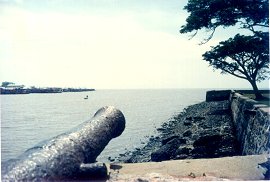 Kedah
purchased over 30 cannon from the Portuguese in 1650, some of which
were used to strengthen Kota Kuala Kedah's defences. These were to
indeed prove useful during the Bugis period of dominance in the next
century. The Bugis leader Daeng Parani, with a strong force of 62 war
boats from Riau and Selangor, invaded Kedah in 1724 and took an active
part in the power struggle between Sultan Muhammad Jiwa and the
Sultan's younger brother who was plotting to overthrow him. Daeng
Parani sided with the ruling Sultan, while the Sultan's younger brother
invited Raja Kechil and his Minangkabau followers to oust the Bugis
from Kedah. Raja Kechil occupied Kota Kuala Kedah but another fleet of
warboats led by Daeng Parani's brother, Daeng Merewah, succeeded in
driving Raja Kechil and his forces out of Kedah back to Siak. The war
lasted two years and devastated Kedah. Kedah
purchased over 30 cannon from the Portuguese in 1650, some of which
were used to strengthen Kota Kuala Kedah's defences. These were to
indeed prove useful during the Bugis period of dominance in the next
century. The Bugis leader Daeng Parani, with a strong force of 62 war
boats from Riau and Selangor, invaded Kedah in 1724 and took an active
part in the power struggle between Sultan Muhammad Jiwa and the
Sultan's younger brother who was plotting to overthrow him. Daeng
Parani sided with the ruling Sultan, while the Sultan's younger brother
invited Raja Kechil and his Minangkabau followers to oust the Bugis
from Kedah. Raja Kechil occupied Kota Kuala Kedah but another fleet of
warboats led by Daeng Parani's brother, Daeng Merewah, succeeded in
driving Raja Kechil and his forces out of Kedah back to Siak. The war
lasted two years and devastated Kedah.
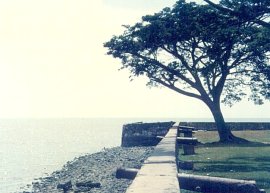 The
Bugis were again playing kingmakers when, in 1771, they supported
dissident forces in Kedah out to depose the ruling Sultan Abdullah
Mukarram Shah. They captured Kota Kuala Kedah that year and it is said
they seized over 300 brass cannons of all calibres in the battle.
However, the Sultan obtained the help of the English trader-adventurer
Captain Francis Light, who re-captured the fort for the Sultan and used
it as a base. In return, Light promised to use the fort to protect the
Sultan from any attacks that might take place from the Kedah river
estuary. It was probably this promise that led the Sultan to believe
for so long that English would provide him with military aid against
his enemies - in particular his overlords the Siamese. This promise
that was never kept. The
Bugis were again playing kingmakers when, in 1771, they supported
dissident forces in Kedah out to depose the ruling Sultan Abdullah
Mukarram Shah. They captured Kota Kuala Kedah that year and it is said
they seized over 300 brass cannons of all calibres in the battle.
However, the Sultan obtained the help of the English trader-adventurer
Captain Francis Light, who re-captured the fort for the Sultan and used
it as a base. In return, Light promised to use the fort to protect the
Sultan from any attacks that might take place from the Kedah river
estuary. It was probably this promise that led the Sultan to believe
for so long that English would provide him with military aid against
his enemies - in particular his overlords the Siamese. This promise
that was never kept.
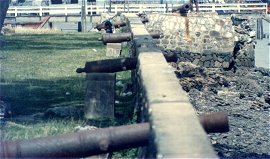 The
fort had earlier been constructed of hardened clay and earthworks,
reinforced with stout timber beams. In 1771, Sultan Abdullah decided to
strengthen it further - particularly to take into account the much
larger calibre cannon now being used by his adversaries the Bugis and
the Siamese, as well as the new siege tactics of the time. Its walls
were made stouter with stonework and brickwork and incorporated
'modern' features such as parapets and peepholes for firing muskets.
The cannon were also replaced with bigger calibre guns purchased from
the English, Dutch, Achehnese, Minangkabaus and Brunei Malays.
Construction was finally completed in 1780. The
fort had earlier been constructed of hardened clay and earthworks,
reinforced with stout timber beams. In 1771, Sultan Abdullah decided to
strengthen it further - particularly to take into account the much
larger calibre cannon now being used by his adversaries the Bugis and
the Siamese, as well as the new siege tactics of the time. Its walls
were made stouter with stonework and brickwork and incorporated
'modern' features such as parapets and peepholes for firing muskets.
The cannon were also replaced with bigger calibre guns purchased from
the English, Dutch, Achehnese, Minangkabaus and Brunei Malays.
Construction was finally completed in 1780.
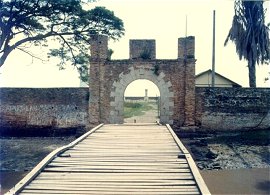 Earlier
fears of the Siamese was realized when, at noon on Sunday November
12th, 1821, a large fleet from Siam sailed into Kuala Kedah. Not
knowing their intentions, the Siamese were welcomed with great ceremony
when they landed by the fort commander Bendahara Dato' Paduka Maharaja
Sura. While being lead around for a tour of the fort, the Thai
commander, the Raja of Ligor, Phya Buri Sakmuton, suddenly ordered his
men to attack. Taken completely by surprise, the garrison was
massacred. The Sultan fled to Penang and, from there, planned a war of
resistance to the Siamese. Earlier
fears of the Siamese was realized when, at noon on Sunday November
12th, 1821, a large fleet from Siam sailed into Kuala Kedah. Not
knowing their intentions, the Siamese were welcomed with great ceremony
when they landed by the fort commander Bendahara Dato' Paduka Maharaja
Sura. While being lead around for a tour of the fort, the Thai
commander, the Raja of Ligor, Phya Buri Sakmuton, suddenly ordered his
men to attack. Taken completely by surprise, the garrison was
massacred. The Sultan fled to Penang and, from there, planned a war of
resistance to the Siamese.
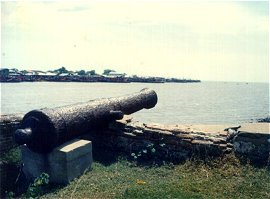 In
1831, the Sultan's son Tunku Kudin led 3000 Malays out of Prai and
drove the Siamese from Kedah. However, facing a Siamese army of 7,500
men and 3,000 elephants, Ku Din was driven back and cornered in Kuala
Kedah fort with only a few hundred men. The Siamese could not breach
the fort's stout walls and had to build wooden siege towers overlooking
the fort, from which they released murderous musket fire upon the
defenders. After a bloody siege lasting three months, the fort was
stormed and Ku Din's head was sent to Bangkok. In
1831, the Sultan's son Tunku Kudin led 3000 Malays out of Prai and
drove the Siamese from Kedah. However, facing a Siamese army of 7,500
men and 3,000 elephants, Ku Din was driven back and cornered in Kuala
Kedah fort with only a few hundred men. The Siamese could not breach
the fort's stout walls and had to build wooden siege towers overlooking
the fort, from which they released murderous musket fire upon the
defenders. After a bloody siege lasting three months, the fort was
stormed and Ku Din's head was sent to Bangkok.
| Another Malay attack in 1838 not only won them their
homeland again but even managed to take the war to Siamese territory,
allowing them to liberate Patani and besiege Singora (Songkhla). But as
before, heavy reinforcements arrived from Bangkok and the Kedah Malays
made one final last stand at Kota Kuala Kedah. Two hundred men held out
to the end, surrounded on land by 15,000 Siamese infantry equipped with
modern muskets, artillery and elephants. At sea, the British 18-gun
warship 'Hyacinth' and three gunboats blockaded the fort. After
terrible massacres and atrocities on both sides, the defenders were
overwhelmed and triumphant Siamese captured the fort in the early hours
of March 20th.
That last stand of the Kedah's independence also marked
the last time ever Kota Kuala Kedah cannon's were fired in anger.
|
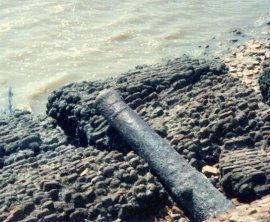
Known locally as 'Meriam Badak
Berendam' ('The Wallowing Rhino'), this cannon is lodged in the mud
among debris of the collapsed sea wall, below tide level. Popular
belief maintains that it is inhabited by a Spirit Guardian, as all
attempts to remove it have so far been unsuccessful
|
Write to the author: sabrizain@malaya.org.uk
The
Sejarah Melayu
website is
maintained solely by myself and does not receive any funding
support from any governmental, academic, corporate or other
organizations. If you have found the Sejarah Melayu website useful, any
financial contribution you can make, no matter how small, will be
deeply appreciated and assist greatly in the continued maintenance of
this site.
|
|

